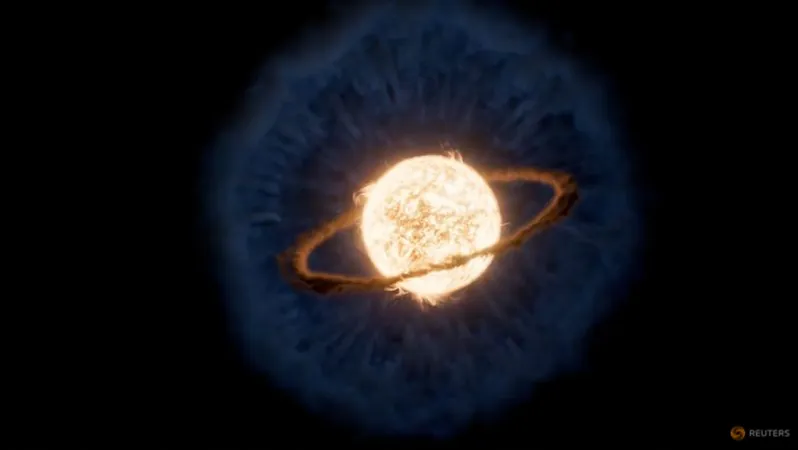
Astronomers Unveil Dramatic Death Plunge of Alien Planet into Star
2025-04-11
Author: Rajesh
A Cosmic Catastrophe Unveiled
In a stunning revelation, astronomers have documented the heart-stopping moment when an alien planet met its fiery end as it was consumed by its host star. This cosmic drama unfolded in May 2020 but has since taken an unexpected twist thanks to the groundbreaking observations from the James Webb Space Telescope.
A Fatal Collision: More Than Meets the Eye
Initially, scientists believed the planet was devoured as its star expanded into a red giant, but new data suggests a far more chilling scenario: the planet spiraled into the star after its orbit decayed over time. This dramatic plunge painted a different picture of its demise, reshaping our understanding of planetary deaths across the universe.
Witnessing the Aftermath
The aftermath of this celestial collision is nothing short of spectacular. The James Webb Space Telescope, operational since 2022, captured an array of hot gas likely forming a glowing ring around the star, accompanied by a cloud of cooler dust as evidence of the planet's catastrophic plunge. "Material from the star was expelled during the planet's downward trajectory, creating a dusty halo that we can now observe," explained Ryan Lau, lead investigator.
A Giant Among Giants: The Planet's Profile
Astronomers hypothesize that the doomed planet was a "hot Jupiter" — a massive gas giant with scorching temperatures due to its close orbit to its star. Morgan MacLeod, a co-author of the study, revealed, "This planet must have been at least several times the mass of Jupiter to cause such a monumental disturbance in the stellar atmosphere." Jupiter, known as the largest planet in our solar system, serves as a reference point for this cosmic giant.
Grazing Through Stellar Atmospheres
As the planet's orbit soaked up intense gravitational pull from the star, it ultimately began its descent into the stellar atmosphere. "At this point, the headwind of the stellar atmosphere kicks in and propels the planet downward at an alarming rate, stripping it of its gaseous layers in the process. The collision creates heat and expels stellar gas that illuminates the cosmic landscape we observe today," MacLeod added.
The Mystery of the Planet's Fate
While we’ve witnessed the star responding to its planetary demise, the exact fate of the planet remains shrouded in mystery. As astronomers like MacLeod acknowledge, "In astronomy, we can't conduct lab experiments; we must rely on simulations to piece together these monumental events." Indeed, the colossal scales of these cosmic encounters make real-time experimentation impossible.
A Future Warning for Our Solar System?
In our own solar system, planets aren’t close enough to the sun for their orbits to decay as seen with this alien planet. However, about five billion years from now, our sun is projected to enter its red giant phase, likely engulfing Mercury, Venus, and possibly Earth in a similar fate. As such, Webb’s findings urge us to consider the long-term stability of planetary systems: "Our observations suggest that planets might spiral into stars more often than previously believed, instead of being eaten by an expanding star," cautioned Lau.
Conclusion: A Glimpse of the Cosmic Cycle
The revelations from the James Webb Space Telescope offer an unprecedented glimpse into the astronomical endgames orchestrated by chilling cosmic forces. As we continue to explore the mysteries of the universe, this signal from the demise of one world serves as a striking reminder of the epic cycles at play among the stars.

 Brasil (PT)
Brasil (PT)
 Canada (EN)
Canada (EN)
 Chile (ES)
Chile (ES)
 Česko (CS)
Česko (CS)
 대한민국 (KO)
대한민국 (KO)
 España (ES)
España (ES)
 France (FR)
France (FR)
 Hong Kong (EN)
Hong Kong (EN)
 Italia (IT)
Italia (IT)
 日本 (JA)
日本 (JA)
 Magyarország (HU)
Magyarország (HU)
 Norge (NO)
Norge (NO)
 Polska (PL)
Polska (PL)
 Schweiz (DE)
Schweiz (DE)
 Singapore (EN)
Singapore (EN)
 Sverige (SV)
Sverige (SV)
 Suomi (FI)
Suomi (FI)
 Türkiye (TR)
Türkiye (TR)
 الإمارات العربية المتحدة (AR)
الإمارات العربية المتحدة (AR)